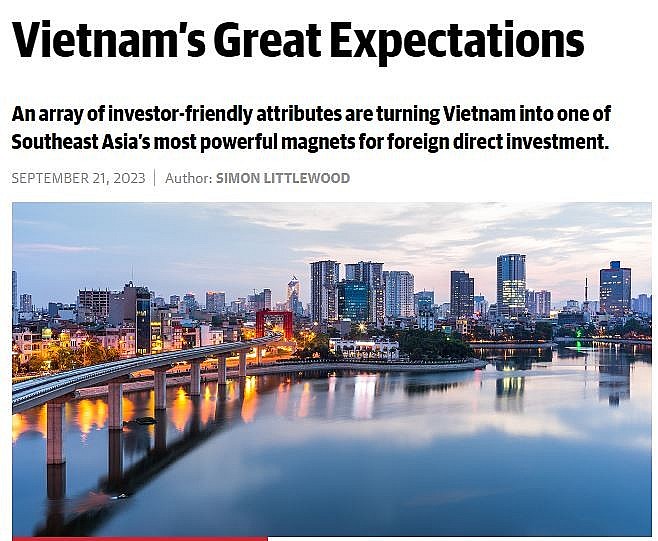On September 21, Global Finance Magazine published an article titled “Vietnam’s Great Expectations,” which highlights Vietnam as one of the leading countries in Southeast Asia in attracting foreign direct investment (FDI).
The article attributes this success to various factors, including Vietnam’s favorable demographics with 40% of its 100 million population under 25. Additionally, its membership in the Association of Southeast Asian Nations (ASEAN) provides tariff-free access to a region with 800 million people.

|
| Screenshot from the article. |
“The 2023 outlook for the business environment in Vietnam shows promising signs of improvement,” says Thierry Mermet, CEO of Source Of Asia (SOA), a consultant for businesses seeking opportunities in Vietnam and ASEAN. “Foreign direct investment capital reached approximately $10 billion [in Q1 of 2023], representing a 0.5% increase compared to the same period last year.” SOA projects that this trend will continue. “Our projections for the next quarter are equally positive, with companies anticipating similar levels of foreign direct investment.”
Looking ahead, Mermet states, “Vietnam is solidifying its position as one of the top three destinations for European business leaders’ investments.” According to the Business Confidence Index report from EuroCham, “3% more business leaders have selected Vietnam as one of their top three investment choices. This serves as a strong indication that we are on the right path.”
The article also notes that 90 countries and territories invested in Vietnam in the first half of the year, with Asian countries dominating the list. South Korea ranks first with $81 billion, followed by Singapore and Japan with commitments of $72 billion and nearly $70 billion, respectively. Although the United States ranks seventh in terms of investment capital, it is Vietnam’s most significant export partner.
Vietnam’s homegrown electric vehicle (EV) manufacturer VinFast is another indicator of the country’s allure. VinFast recently became the world’s third-largest automaker by market capitalization, trailing only Tesla and Toyota.
Barry Elliott, Vice President of Tomkins Ventures and an expert in supply chain management with extensive experience in Vietnam, believes this achievement signals a prosperous future for the EV industry in Southeast Asia as well as the emergence of Vietnam as a manufacturing powerhouse.
Furthermore, S&P Global highlights Vietnam’s robust economic growth as a factor attracting foreign investors. Although the country’s economic growth slowed to 3.7% in the first half of 2023 from 8% in 2022, the World Bank predicts a rebound in the second half of the year.
S&P Global also forecasts an increase in mergers and acquisitions in Vietnam’s banking sector over the next two years as lenders aim to strengthen their capital.
During a recent visit to Ho Chi Minh City, Jacqueline Poh, managing director of Singapore’s Economic Development Board (EDB), met with startups in financial services, robotics, and renewables. Poh emphasized the significant influence of the returning Vietnamese diaspora, which is highly regarded as “sea turtles” by the local community due to their experience abroad.
“All have a can-do spirit, support for each other, and determination,” says Poh. “These factors have created a conducive environment for local startups.”
Poh also highlights the growth of the Vietnam-Singapore Industrial Parks (VSIPs), which were established in 1996 and now include 17 parks across 10 locations. “The existing 14 VSIPs have attracted $18.7 billion in investment and have created 300,000 jobs in Vietnam,” she notes.
According to Carsten Ley, founder and managing director of Asia PMO, which advises companies on operations in Vietnam, the rise in foreign direct investment can be attributed to incentives and a “China plus one” risk mitigation strategy aimed at diversifying away from China. Ley cites Apple’s decision to relocate iPod production from China to Ho Chi Minh City as an example. He also mentions significant investments from Korean companies such as Samsung and LG in the IT industry, and Lego’s establishment of a large factory outside Ho Chi Minh City.
As these developments illustrate, Vietnam is transitioning from traditional manufacturing sectors like shoes and garments toward high-tech industries. This includes the growth of Vietnamese fintech companies such as Momo, ZaloPay, and VNPay, as well as foreign startups.








